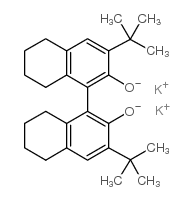(r)-(-)-5,5',6,6',7,7',8,8'-octahydro-3,3'-di-t-butyl-1,1'-bi-2-naphthol, dipotassium salt

(r)-(-)-5,5',6,6',7,7',8,8'-octahydro-3,3'-di-t-butyl-1,1'-bi-2-naphthol, dipotassium salt structure
|
Common Name | (r)-(-)-5,5',6,6',7,7',8,8'-octahydro-3,3'-di-t-butyl-1,1'-bi-2-naphthol, dipotassium salt | ||
|---|---|---|---|---|
| CAS Number | 350683-75-9 | Molecular Weight | 482.78100 | |
| Density | N/A | Boiling Point | N/A | |
| Molecular Formula | C28H36K2O2 | Melting Point | N/A | |
| MSDS | USA | Flash Point | N/A | |
| Name | (r)-(-)-5,5',6,6',7,7',8,8'-octahydro-3,3'-di-t-butyl-1,1'-bi-2-naphthol, dipotassium salt |
|---|---|
| Synonym | More Synonyms |
| Molecular Formula | C28H36K2O2 |
|---|---|
| Molecular Weight | 482.78100 |
| Exact Mass | 482.19900 |
| PSA | 46.12000 |
| LogP | 7.99380 |
|
Section 1: Product Identification Chemical Name:(R)-(-)-5,5',6,6',7,7',8,8'-Octahydro-3,3'-di-t-butyl-1,1'-bi-2-naphthol, dipotassium salt CAS Registry Number:350683-75-9 Formula:C28H36K2O2 EINECS Number:none Chemical Family:alkali alkoxide Synonym:None
Section 2: Composition and Information on Ingredients IngredientCAS NumberPercentACGIH (TWA)OSHA (PEL) Title Compound350683-75-9100%no datano data Section 3: Hazards Identification Emergency Overview:Irritating to eyes and skin. May be harmful if swallowed or inhaled. Primary Routes of Exposure:Ingestion Eye Contact:Causes mild irritation of the eyes. Skin Contact:Causes slight irritation of the skin. Inhalation:Inhalation of dust may lead to irritation of the respiratory tract. Ingestion:No information is available on the physiological effects of ingestion. May be harmful if swallowed. Acute Health Affects:Irritating to eyes and skin. May be harmful if swallowed or inhaled. Chronic Health Affects:No information available on long-term chronic effects. NTP:No IARC:No OSHA:No SECTION 4: First Aid Measures Immediately flush the eyes with copious amounts of water for at least 10-15 minutes. A victim may need Eye Exposure: assistance in keeping their eye lids open. Get immediate medical attention. Wash the affected area with water. Remove contaminated clothes if necessary. Seek medical assistance if Skin Exposure: irritation persists. Remove the victim to fresh air. Closely monitor the victim for signs of respiratory problems, such as difficulty Inhalation: in breathing, coughing, wheezing, or pain. In such cases seek immediate medical assistance. Seek medical attention immediately. Keep the victim calm. Give the victim water (only if conscious). Induce Ingestion: vomiting only if directed by medical personnel. SECTION 5: Fire Fighting Measures Flash Point:none Autoignition Temperature:none Explosion Limits:none Extinguishing Medium:carbon dioxide, dry powder or foam Fire fighters should be equipped with a NIOSH approved positive pressure self-contained breathing apparatus Special Fire Fighting Procedures: and full protective clothing. Hazardous Combustion andIf involved in a fire this material may emit toxic organic fumes. Decomposion Products: Unusual Fire or Explosion Hazards: No unusual fire or explosion hazards. SECTION 6: Accidental Release Measures Spill and Leak Procedures:Small spills can be mixed with vermiculite or sodium carbonate and swept up. SECTION 7: Handling and Storage Handling and Storage:Store in a cool, dry place in a tightly sealed container. SECTION 8: Exposure Controls and Personal Protection Eye Protection:Always wear approved safety glasses when handling a chemical substance in the laboratory. Skin Protection:Wear protective clothing and gloves. Consult with glove manufacturer to determine the proper type of glove. Ventilation:If possible, handle the material in an efficient fume hood. If ventilation is not available a respirator should be worn. The use of respirators requires a Respirator Respirator: Protection Program to be in compliance with 29 CFR 1910.134. Ventilation:If possible, handle the material in an efficient fume hood. Additional Protection:No additional protection required. SECTION 9: Physical and Chemical Properties Color and Form:cream-colored powder Molecular Weight:482.8 Melting Point:no data Boiling Point:no data Vapor Pressure:no data Specific Gravity:no data Odor:none Solubility in Water:soluble SECTION 10: Stability and Reactivity Stability:moisture sensitive Hazardous Polymerization:no hazardous polymerization Conditions to Avoid:none Incompatibility:oxidizing agents Decomposition Products:carbon monoxide, carbon dioxide, organic vapors and metal oxides. SECTION 11: Toxicological Information RTECS Data:No information available in the RTECS files. Carcinogenic Effects:no data Mutagenic Effects:no data Tetratogenic Effects:no data SECTION 12: Ecological Information Ecological Information:No information available SECTION 13: Disposal Considerations Disposal:Dispose of according to federal, state, and local regulations. SECTION 14: Transportation Shipping Name (CFR):Non-hazardous Hazard Class (CFR):NA Additional Hazard Class (CFR):NA Packaging Group (CFR):NA UN ID Number (CFR):NA Shipping Name (IATA):Non-hazardous Hazard Class (IATA):NA Additional Hazard Class (IATA):NA Packaging Group (IATA):NA UN ID Number (IATA):NA SECTION 15: Regulatory Information TSCA:Not listed in the TSCA inventory. SARA (Title 313):Title compound not listed. Second Ingredient:none SECTION 16 - ADDITIONAL INFORMATION N/A |
|
A Readily Available and User-Friendly Chiral Catalyst for Efficient Enantioselective Olefin Metathesis This research was supported by the National Institutes of Health (GM-59426) and the National Science Foundation (CHE-9905806 to A. H. H. and CHE-9988766 to R. R. S.).
Angew. Chem. Int. Ed. Engl. 40 , 1452, (2001)
|
|
|
Efficient catalytic enantioselective synthesis of unsaturated amines: preparation of small- and medium-ring cyclic amines through mo-catalyzed asymmetric ring-closing metathesis in the absence of solvent.
J. Am. Chem. Soc. 124 , 6991, (2002) The first catalytic asymmetric ring-closing metathesis method for the synthesis of N-containing heterocycles is reported; this is accomplished through Mo-catalyzed kinetic resolution or desymmetrizati... |
|
|
S.L. Aeilts et al.
Angew. Chem. Int. Ed. Engl. 113 , 1500, (2001)
|
| 5,5',6,6',7,7',8,8'-Octahydro-3,3'-di-T-butyl-1,1'-bi-2-naphthol dipotassium salt |
| 5,5',6,6',7,7',8,8'-OCTAHYDRO-3,3'-DI-TERT-BUTYL-1,1'-BI-2-NAPHTHOL DIPOTASSIUM SALT |